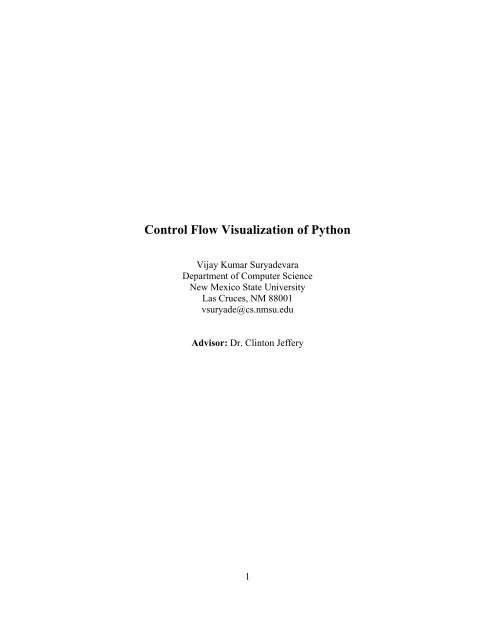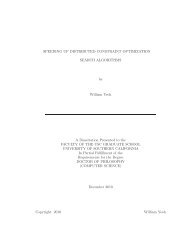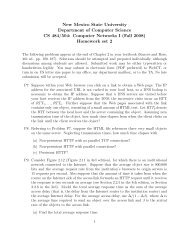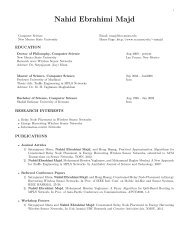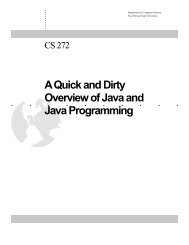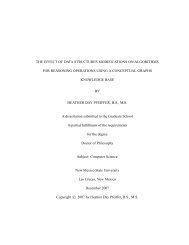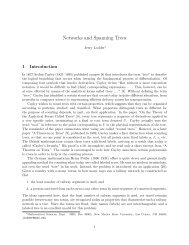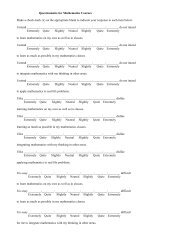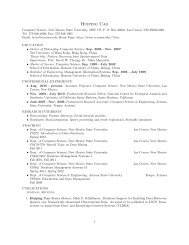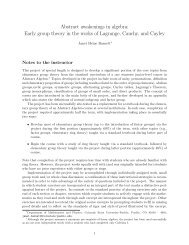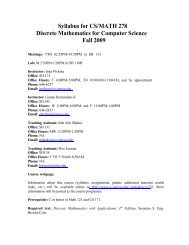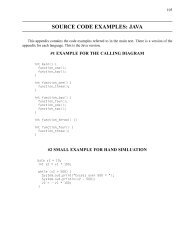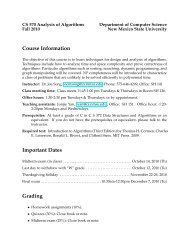Control Flow Visualization of Python - New Mexico State University
Control Flow Visualization of Python - New Mexico State University
Control Flow Visualization of Python - New Mexico State University
You also want an ePaper? Increase the reach of your titles
YUMPU automatically turns print PDFs into web optimized ePapers that Google loves.
<strong>Control</strong> <strong>Flow</strong> <strong>Visualization</strong> <strong>of</strong> <strong>Python</strong>Vijay Kumar SuryadevaraDepartment <strong>of</strong> Computer Science<strong>New</strong> <strong>Mexico</strong> <strong>State</strong> <strong>University</strong>Las Cruces, NM 88001vsuryade@cs.nmsu.eduAdvisor: Dr. Clinton Jeffery1
AbstractThis project aims to visualize the control flow <strong>of</strong> <strong>Python</strong> programs. It has thepotential to make debugging easier and to help in performance tuning. The visualizationsalso help in understanding the program behavior. Pr<strong>of</strong>iling and tracing facilities providedby the <strong>Python</strong> Interpreter are used in tracing the events <strong>of</strong> the user program. <strong>Python</strong>doesn’t support graphics on its own. V<strong>Python</strong> graphics package is used to draw thevisualizations. Two visualization tools are designed in this project. The first onevisualizes control flow in a program at line level and the other one at the function/methodcall level. The line level visualization is a 3-dimensional plot with line number beingexecuted as y-coordinate, final event in the current call as x-coordinate and the stackdepth as z-coordinate. The function/method call visualization shows the control flow in aprogram using arrow and sphere objects. The functions and classes in a program arerepresented by sides <strong>of</strong> a polygon and the calls between them are represented by arrowsfrom caller to called. Recursive calls are represented using sphere objects.2
1. IntroductionProgram visualization is a promising area <strong>of</strong> s<strong>of</strong>tware engineering and is a branch<strong>of</strong> s<strong>of</strong>tware visualization. Program visualization is a process <strong>of</strong> depicting the dynamicbehavior <strong>of</strong> an executing program by continuously updating a graphic display orrepresenting the program’s control and/or data with the help <strong>of</strong> graphics at a particularmoment 1 . Several important applications <strong>of</strong> program visualization include debugging,performance tuning, and the study <strong>of</strong> algorithms.<strong>Control</strong> flow visualization is a part <strong>of</strong> program visualization which deals withgraphical representation <strong>of</strong> control in a program. This project is about control flowvisualization <strong>of</strong> <strong>Python</strong> programs. <strong>Python</strong> is an interpreted, interactive, object orientedprogramming language 2 . This work aims to visualize the control flow in <strong>Python</strong>programs with the goal <strong>of</strong> making debugging easier and improving the performance.The sys module <strong>of</strong> <strong>Python</strong> has functions for enabling pr<strong>of</strong>iling and tracingfunctions 3 . There is also a low-level support for attaching pr<strong>of</strong>iling and execution tracingfacilities in <strong>Python</strong>. The <strong>Python</strong> Interpreter provides a C interface that allows pr<strong>of</strong>iling ortracing code by making a direct C function call instead <strong>of</strong> calling through <strong>Python</strong>-levelcallable objects 4 . <strong>Python</strong>-level hooks take 60 – 70% more time when compared to thehooks provided by C interface for event tracing. More information about tracing andpr<strong>of</strong>iling hooks provided by the sys module and the C interface <strong>of</strong> <strong>Python</strong> is present inAppendix A.One <strong>of</strong> the limitations <strong>of</strong> using <strong>Python</strong>’s built-in tracing facilities is that it isdifficult to visualize the control flow at expression level as these hooks don’t provide anyinformation <strong>of</strong> expression-evaluation. The tracing facilities can only provide informationup to the line-level.Two visualization tools are developed in this project. The first tool uses the Cinterface provided by the <strong>Python</strong> Interpreter for enabling the trace function. The secondtool includes a 3D-visualization and 2D-visualization which uses <strong>Python</strong> level pr<strong>of</strong>ilingfacilities. Attempts to use the C interface for setting pr<strong>of</strong>iling function failed in thesecond visualization tool. The reason for it is described in the Limitations section.Graphics output is not supported by <strong>Python</strong> on its own. V<strong>Python</strong> 5 is used as thegraphics package for the control flow visualization. V<strong>Python</strong> consists <strong>of</strong> a graphics3
module called Visual, developed by David Scherer in 2000 when he was a sophomore atCarnegie Mellon <strong>University</strong>. Visual reflects the current positions <strong>of</strong> objects by refreshinga 3D scene many times per second 5 . The programmer can zoom and rotate a 3D sceneeasily with the help <strong>of</strong> a mouse.V<strong>Python</strong> was selected over other graphics packages because <strong>of</strong> the presence <strong>of</strong>high level objects like sphere, arrow, and curve that can be readily used. Appendix B liststhe objects used from V<strong>Python</strong> and has brief notes on each <strong>of</strong> this object.The next section describes the first tool which visualizes control flow at linelevel.It describes the tracing hooks used, implementation <strong>of</strong> LineTracer module,visualization program Graph.py and also presents some screenshots. Section 3 presentsthe second tool which visualizes the interaction between the functions, classes andmethods <strong>of</strong> a source program. It introduces the pr<strong>of</strong>iling hooks used, implementation <strong>of</strong>Visualizer module, CallGraph module, CallGraph2D module. Section 4 presentsinteresting screenshots. Limitations <strong>of</strong> this project are discussed in Section 5. Section 6concludes the paper.2. Line level <strong>Visualization</strong>This visualization is a 3-dimensional plot with number <strong>of</strong> events in a call as x-axis, line number being executed as y-axis and stack depth as z-axis. All the line, calland return events occurring in a source program are plotted in this visualization. Each <strong>of</strong>the events is represented using a sphere object.Before executing the source program, user has to import LineTracer module in hisprogram. LineTracer is a <strong>Python</strong> extension module written in C to trace the eventsoccurring in a program. It uses the <strong>Python</strong>’s C interface for tracing the events.There are two steps <strong>of</strong> execution for visualizing control flow in the user program.First the user has to execute the source program after importing LineTracer.python ProgramName.pyA log file LineEvents.txt is created as a result <strong>of</strong> this step. The next step is to executeGraph.py which uses this log file to show the visualization.python Graph.py4
2.1 LineTracerLineTracer is a <strong>Python</strong> extension module written in C for tracing events in aprogram. It uses the pr<strong>of</strong>iling and tracing hooks provided by the C interface <strong>of</strong> the <strong>Python</strong>Interpreter. It is written using the <strong>Python</strong>’s API 6 (Application Programmers Interface)which defines a set <strong>of</strong> functions, macros and variables that provide access to most aspects<strong>of</strong> the <strong>Python</strong> to support extension <strong>of</strong> <strong>Python</strong> .LineTracer installs a trace function, TraceEvents. The Interpreter callsTraceEvents after every line, call, return, and exception event with correspondingparameters. TraceEvents extracts the required information for visualizing the control flowfrom these parameters and writes it into a log file LineEvents.txt. Information from thislog file is used by Graph.py to plot the visualization.The user has to import LineTracer module in his program and call theTraceInstaller( ) with the name <strong>of</strong> source program as parameter in order to trace theevents.import LineTracerLineTracertrace.TraceInstaller (programName)The TraceInstaller( ) uses programName to limit the trace to present program and stop itfrom entering the other imported modules.TraceInstaller( ) installs the trace function TraceEvents( ) using PyEval_SetTracestatement.PyEval_SetTrace ((Py_tracefunc) TraceEvents, (PyObject *) self);int TraceEvents (PyObject *obj, PyFrameObject *f, int what, PyObject *args)An array <strong>of</strong> counters, stack[ ], is maintained to keep track <strong>of</strong> call-stack depth andthe number events in the current call at every instance. The index <strong>of</strong> the array at eachinstance gives the stack depth at that instance whereas the value in the array at this indexgives the number <strong>of</strong> line events in this call. When a new call is entered the index <strong>of</strong> thearray is increased and when a call is returned it is decreased. The value in the array atcurrent index is increased with every line event.From the frame object passed by the Interpreter, TraceEvents( ) determines theline number being executed in the source program and also the method to which the5
current line belongs. frame->f_lineno is the line number and frame->f_code->co_nameis the function/method name. Appendix A lists the members <strong>of</strong> frame and code objectswith brief description for each member.TraceEvents( ) writes the current call-stack depth, line number being executed,number <strong>of</strong> events in the current call, function/method name <strong>of</strong> the current event into a logfile LineEvents.txt.fprintf ( fptr, "%d,%d,%d,%s\n", stack[index], f->f_lineno, index+1, PyString_AS_STRING (f -> f_code-> co_name ));The user has to execute Graph.py to get the control flow visualization. Graph.pyreads the LineEvents.txt and plots the visualization using this information.2.2 Graph.pyGraph.py plots a 3-dimensional graph with number <strong>of</strong> events in the current call,line number in the source code, and stack depth as x, y and z coordinates. The graph isplotted with the sphere objects in a display window <strong>of</strong> V<strong>Python</strong>. Each sphere in the graphrepresents an event (line, call, return).If all the events are plotted, the Graph looks complex and denser which makes ithard to understand. Hence only function/method call, return and final event in each callare plotted. Although a sphere is plotted for every event in a call, only the sphererepresenting final event in a call is kept and the remaining are deleted.After all the events are plotted, a user can know the information <strong>of</strong> an eventrepresented by a sphere object in the 3D-graph. A left click <strong>of</strong> the mouse on a sphereobject prints the information <strong>of</strong> the event represented by it. This information includesstack depth, line number, number <strong>of</strong> events in that call and method name. All theinformation is printed in the shell. A dictionary object dictMethods is used to keep track<strong>of</strong> all the sphere objects plotted.Algorithm Graph.pybegindef Plot( ){zprev = -1for each line in log file {Parse each line to get x, y, z coordinates and methName.6
if z == zprev {event.visible = 0event= sphere (pos = (x,y,z), radius=0.2)dictMethods[methName ] = (x,y,z)}else {event = sphere (pos = (x,y,z), radius=0.2)dictMethods[methName ] = (x,y,z)}z=zprev}}scene = display (title='<strong>Visualization</strong>', height=1000, width=800)dictMethods = { }Plot( )While 1: {if (scene.mouse.clicked){p = get position on the screenSearch for p in the values <strong>of</strong> dictMethods.if there is a match:Print p, key in dictMethods where this match was found.else:Print “No sphere object selected”}}endFigure 1: Algorithm <strong>of</strong> Graph.pyFigure 1 shows the algorithm <strong>of</strong> Graph.py. The Graph.py creates a displaywindow titled “<strong>Visualization</strong>” by using the display object <strong>of</strong> Vpython.scene = display (title='<strong>Visualization</strong>', height=1000, width=800)The Plot( ) reads the log file line by line. Each line in the LineEvents.txt corresponds toan event. It parses each line to get method name and x, y, z coordinates. Plot( ) maintainsa dictionary DictMehods, with method names as keys and list <strong>of</strong> (x, y, z) as values. Itplots the current event in the display window by calling the sphere object <strong>of</strong> Vpython.ball = sphere (pos=(x, y, z), radius=0.2, display=scene, color=color. cyan)The above statement plots a sphere called ball at position (x, y, z) with radius 0.2 in thedisplay window scene with the given color.Before plotting a sphere, the Plot( ) function checks if the current event belongs to7
the same call or not. This is determined by comparing the z-coordinate (stack depth) <strong>of</strong>the current event and the previous event. If they are same then both the events belong tothe same call. Hence the previous plotted sphere is deleted and the new one is plotted.Also the dictMethod is updated by deleting the (x, y, z) <strong>of</strong> previous event and inserting(x, y, z) <strong>of</strong> current event.If the z-coordinates are not equal, they belong to different calls. Hence the newsphere is plotted without deleting the old sphere. In this case dictMethod is updated byinserting (x, y, z) <strong>of</strong> current event.The function call events are represented using green colored spheres whereas thereturns are represented using red colored spheres. When a function call is made, the z-coordinate <strong>of</strong> present event will be greater than the previous one. For such events, a greencolored sphere is plotted. When a return occurs, the z-coordinate <strong>of</strong> present event will beless than the previous one. For such events, a red colored sphere is plotted. In both thecases, dictMethod is updated by inserting (x, y, z) <strong>of</strong> present event.When a sphere object in the display window is selected, the position <strong>of</strong> sphere isobtained from scene.mouse.getclick( ) <strong>of</strong> V<strong>Python</strong>. This position <strong>of</strong> the sphere object issearched in the values <strong>of</strong> dictMethod. If there is a match, the key corresponding to thevalue at which this match occurred is the method name to which the event pertains. Themethod name and the position <strong>of</strong> the sphere which corresponds to number <strong>of</strong> events inthat call, line number in the source code and stack depth are printed on the shell.2.3 ScreenshotsFigures 2(a) and 2(b) show control flow in Polynomial.py 7 . It is written by RickMuller for calculating addition, multiplication, derivatives, and integrals <strong>of</strong> polynomialsand also has simple functions that convert polynomials to a python list. The onlyadditions made to Polynomial.py for visualizing the control flow was to include the“import LineTracer” and “LineTracer.TraceEvents(‘Polynomial.py’)” statements.8
Figure 2(a): control flow in Polynomial.pyThe visualization in Figure 2(a) shows axis lines and sphere objects. Each sphere objectcorresponds to a line, call or return event. The call events are represented using greencolored spheres and the return events are represented using red colored spheres. Thewhite colored spheres represent line events. Though a sphere is drawn for each line event,only the sphere representing final event in a particular call is kept and others are deleted.9
The position <strong>of</strong> the spheres is based on Number <strong>of</strong> Events in Current Call, LineNumber and Stack Depth. The z-dimension <strong>of</strong> each sphere object gives an idea <strong>of</strong> howdeep the present call is in the program. If the z-cordinate is high, the stack depth is highand hence the program has to complete many calls before coming to an end.Figure 2(b): Zoomed and Rotated version <strong>of</strong> Figure 2(a).In Figure 2(b), the sphere in cyan color represents the end <strong>of</strong> the program. Green coloredspheres representing the function calls have a low x-coordinate as expected since this willbe the first event in the call. The function returns represented by red colored spheres havea high x-coordinate as expected since they are the final events in a call.10
This first visualization was intended to try and see whether the Pr<strong>of</strong>iling andTracing hooks provided by the <strong>Python</strong> Interpreter are helpful. Another goal was to getfamiliarized with V<strong>Python</strong>. I think this tool served a very good practice exercise in terms<strong>of</strong> understanding the Pr<strong>of</strong>iling and Tracing hooks and also Vpython but nothinginteresting regarding control flow could be seen using it.3. Second <strong>Visualization</strong> ToolOne <strong>of</strong> the problems with the line level visualization is that it has a lot <strong>of</strong> events todepict which makes it look complex and less informative. This visualization overcomesthis problem by plotting only the function/method call events in a program. Visualizer.pyrepresents the functions and classes present in the source program by the sides <strong>of</strong> apolygon. The call events are represented by plotting arrows from caller to calledfunction/method.There process for obtaining visualization is very simple. It is a single stepprocess. There is no need to import any modules into user program. The Visualizer.pyshould be executed with the name <strong>of</strong> user program as a command line argument. Otheroptional parameters and the method <strong>of</strong> executing Visualizer is:python Visualizer.py [-d] [-a] progName [Args]If the ‘-d’ option is 2; a 2D visualization for the progName is plotted. If it is 3; a 3Dvisualization is plotted. By default 3D visualization is plotted. The ‘-a’ flag definesnumber <strong>of</strong> arrows to be shown in the visualization at every instance. The recent ‘a’number <strong>of</strong> arrows are shown and the older arrow is deleted. Default value for ‘-a’ is 50.This ‘-a’ flag is not applicable for 2D visualization.3.1 Visualizer.pyFigure 3(a) gives an overview <strong>of</strong> Visualizer.py. The main function in it prepares aplatform to launch the visualization according to the user’s input. It parses the commandline arguments and assigns values for the variables visualization, numOfArrows andprogName which correspond to type <strong>of</strong> visualization, number <strong>of</strong> arrows to be shown ateach instance and program that is to be visualized.11
Parse the command lineargumentssys.setpr<strong>of</strong>ile(eventTracer)execfile(progName)sys.setpr<strong>of</strong>ile(None)YesCheck if –dflag is 2Noexecfile(CallGraph2D)execfile(CallGraph)Figure 3(a): Visualizer.pyThe log file events.txt is opened in the append mode to write the pr<strong>of</strong>iling results.A pr<strong>of</strong>iling function is installed using sys.setpr<strong>of</strong>ile(eventTracer). In this visualization,the sys module’s setpr<strong>of</strong>ile function is chosen instead <strong>of</strong> settrace because the visualizationdoesn’t need information about line events.The user’s program is executed by using <strong>Python</strong>’s built-in function execfile( )which takes progName as the parameter. During its execution, the <strong>Python</strong> Interpretercalls eventTracer( ) for every call and return event with specific parameters. Requiredinformation for visualizing the control flow such as name <strong>of</strong> the caller, and called areextracted and written into log file events.txt. Figure 3(b) describes the algorithm <strong>of</strong>eventTracer( ).12
frame.f_code.co_name returns the name <strong>of</strong> the called function or method. If amethod is called, the name <strong>of</strong> the class to which this method belongs to is obtained fromframe .f_locals["self"].__class__. __name__.The name <strong>of</strong> calling function/method is obtained from frame. f_back.f_code.co_name 13 . Similarly frame. f_back.f_locals["self"].__class__. __name__ returns theclass name to which this method belongs. Appendix A provides more information aboutframe and code objects.def eventTracer ( frame, event, arg){if (event == “call”){if called is Method:if caller is Method:logfile.write (Method, Called Method Name, Class Name,Method, Calling Method Name, Class Name)else:logfile.write (Method, Called Method Name, Class Name,Function, Function Name)else:if caller is Method:logfile.write (Function, Function Name, Method, CallingMethod Name, Class Name)else:logfile.write (Function, Called Function Name, Function,Calling Function Name)}}Figure 3(b): eventTracer functionAfter executing the user’s program, the pr<strong>of</strong>iling function is disabled by usingsys.setpr<strong>of</strong>ile(None). The 2D or 3D visualization program is invoked depending on theuser’s choice.3.2 CallGraph.pyThe 3D visualization program CallGraph uses the information from events.txt toplot the visualization. It iterates two times over the log file events.txt. In the first iterationit finds all the classes, methods and functions in the user program and stores them into13
dictionary and list objects. In the second iteration it plots the arrows in <strong>Control</strong> <strong>Flow</strong><strong>Visualization</strong> window. CallGraph uses an ordered dictionary instead <strong>of</strong> the ordinarydictionary object provided by python. It imports odict 8 module written by Nicola Larosaand Michael Foord which defines the OrderedDict class. The reason for usingOrderedDict is explained later in the second paragraph <strong>of</strong> section 3.3.2.CallGraph plots the control flow <strong>of</strong> a program using arrow and sphere objects.CallGraph draws an irregular polygon on XY axis with each side representing a functionor Class <strong>of</strong> the user program. The side representing to a class is further divided torepresent methods. These sub-divisions are colored blue and green alternately todifferentiate the methods in that class.The length <strong>of</strong> each side in the polygon is proportional to total number <strong>of</strong> callsmade and received by the corresponding function or Class. The length <strong>of</strong> eachsubdivision representing a method is proportional to total calls made and received by itwhen compared to its Class. Arrows are drawn from the calling function to calledfunction with tip <strong>of</strong> the arrow pointing called function.Figure 4 gives an overview <strong>of</strong> CallGraph.py. CallGraph creates a control windowand two display windows. The control window shows a slider object with which a usercan control the speed with which the arrows are plotted in the <strong>Control</strong> <strong>Flow</strong> <strong>Visualization</strong>display window. Appendix B gives a brief description control window, display windowand slider objects. The first display window is the <strong>Control</strong> <strong>Flow</strong> <strong>Visualization</strong> windowwhere control flow in the user program is plotted. The second display window, Functionsand Classes depicts all the functions and classes present in the user program in the form<strong>of</strong> an irregular polygon.14
Create a <strong>Control</strong> Window and two display windows.Summarize Data from the log file into FuncList, FuncCountList,ClassDict and ClassCountDictDraw Polygon with sides representing functions and classes using datafrom FuncList, FuncCountList, ClassDict and ClassCountDict.(in both the display windows namely, Functions-Classes window and<strong>Control</strong> <strong>Flow</strong> <strong>Visualization</strong> window)Draw Arrow and Sphere objects representing calls by reading the log fileline by line.Before plotting an arrow or sphere, check if the total number <strong>of</strong> arrow andsphere objects is less than 50(default).If it is less, plot the object otherwise Delete Initial Arrow or Sphere objectbefore plotting the new one.Figure 4: CallGraph.pyAlthough the polygon representing functions and classes is plotted in <strong>Control</strong><strong>Flow</strong> <strong>Visualization</strong> window, it is plotted again in the Functions and Classes window tomake the visualization appear clearer. If the user program makes lot <strong>of</strong> calls, the z-coordinate <strong>of</strong> the arrows representing these calls will be increasing and hence the depth <strong>of</strong>the visualization window increases. As a result, the <strong>Control</strong> <strong>Flow</strong> <strong>Visualization</strong> windowwill be scaled to accommodate both the arrows and the polygon. In such case, it will bedifficult to see the polygon in the <strong>Control</strong> <strong>Flow</strong> <strong>Visualization</strong> window.Figures 5(a), 5(b), 5(c) and 5(d) show 3D-visualizations <strong>of</strong> control flow inPolynomial.py.15
Figure 5(a): Functions and Classes in Polynomial.pyIn Figure 5(a), the side labeled ‘?’ represents the main loop in the program. It is not afunction or a class. The sides in cyan color are functions. The side with alternate blue andgreen colors represents Polynomial class. The blue and green colored parts in the siderepresenting Polynomial are the methods present in it. Labels for each side represent thename <strong>of</strong> a function, method or class.16
Figure 5(b): <strong>Control</strong> <strong>Flow</strong> <strong>Visualization</strong> windowEach arrow in Figure 5(b) represents a call event. The arrow is drawn from callingfunction/method to called function/method. Red lines are projected from the origin anddestination <strong>of</strong> the arrows to the sides <strong>of</strong> the polygon.The figures 5(c), 5(d) and 5(e) are taken at different instants <strong>of</strong> visualization andall <strong>of</strong> them show the control flow in Polynomial.py.17
Figure 5(c): <strong>Control</strong> <strong>Flow</strong> <strong>Visualization</strong> windowFrom the Figure 5(c), it can be observed that the visualization shows only a specificnumber <strong>of</strong> arrows at every instant. The older arrows are deleted before drawing the newarrows. This screenshot only shows last 50 arrows. All the previous arrows are deleted.18
Figure 5(d): <strong>Control</strong> <strong>Flow</strong> <strong>Visualization</strong> windowIt can be observed from Figure 5(d) that as the number <strong>of</strong> calls increases, the z-coordinate<strong>of</strong> the arrows increases and hence the depth <strong>of</strong> the visualization increases. In such cases itis difficult to see the polygon in this window and the Functions and Classes window isuseful.19
3.2.1 SummarizeData( )Summarize Data reads the log file events.txt line by line. Each line in theevents.txt corresponds to a function or method call. It parses each line and finds thenames <strong>of</strong> functions, classes and methods present in that line. It makes a list <strong>of</strong> functions(FuncList) and an ordered dictionary <strong>of</strong> classes (ClassDict). Each key-value pair inClassDict corresponds to a class and a list <strong>of</strong> methods ({class : [methods]}). There is alsoa FuncCountList corresponding to FuncList where each entry <strong>of</strong> the FuncCountList holdsthe value for the total number <strong>of</strong> times the function is the caller or is called. There is alsoa ClassCountDict which maintains the values for total number <strong>of</strong> times each method actsas caller or called. Figure 6(a) describes the algorithm <strong>of</strong> SummarizeData( ).import odictClassDict = odict.OrderedDict()ClassCountDict = odict.OrderedDict()FuncList = [ ], FuncCountList = [ ]/* FuncList is list <strong>of</strong> functions in the program.FuncCountList is number <strong>of</strong> times each function is called.ClassDict is an ordered dictionary {className:[meth1,meth2…],…}.ClassCountDict is an ordered dictionary { className:[Number <strong>of</strong> times meth1 is called,Number <strong>of</strong> times meth2 is called…],…}*/def SummarizeData( ){}for each line in logfile{Parse each line to find caller and called.Search for caller and called in in FuncList and ClassDict,.If they are not present, add them to FuncList or ClassDict and incrementcorresponding entries in FuncCountLis and ClassCountDict.If they are already present, just increment corresponding entries inFuncCountLis and ClassCountDict.}Figure 6(a): SummarizeData function20
3.2.2 DrawPolygon( )The DrawPolygon( ) plots an irregular polygon using the FuncList,FuncCountList, ClassDict and ClassCountDict data structures with each side in thepolygon representing a function or a class. FuncCountList and ClassCountDict are usedin evaluation <strong>of</strong> total number <strong>of</strong> calls made and received by the functions, classes andmethods which is useful for determining length <strong>of</strong> each side <strong>of</strong> the polygon.def DrawPolygon( ){x0 = 0 and y0 = 0angle = 0r = 2 * (len(FuncList) + len(ClassDict))lines [ ]// lines[ ] will hold all the curve objects that will be drawn as a part <strong>of</strong> polygon.for i = 1 to len(FuncList){//The length <strong>of</strong> the line will be proportional to number <strong>of</strong> times this//function is called when compared to total number <strong>of</strong> calls in the program.incr = (2*3.14)*NumCalls/TotalCallsangle = angle + incrxnew = x0 + r * cos(angle)ynew = y0 + r * sin(angle)}Draw a line by using curve object between the points (x0, y0) and(xnew, ynew).Store the line object into lines[i].for each key in ClassDict {MethodCurves = [ ]Extract the value which is a list <strong>of</strong> methods.Find length <strong>of</strong> the side for this class which will be proportional to totalcalls made by class when compared to total calls in the class.for each method in list <strong>of</strong> methods{Find length <strong>of</strong> side which will be proportional to number <strong>of</strong> callsmade by this method when compared to total calls in theclass.Find endpoints <strong>of</strong> line that represents this method.Draw a line by using the curve object. The color <strong>of</strong> line will beblue or green depending on the color <strong>of</strong> previous line.21
}}Append this curve object into MethodCurves[ ]}Append MethodCurves list to lines[ ]Figure 6(b): DrawPolygon functionThe algorithm in Figure 6(b) describes the DrawPolygon( ). The polygonrepresenting functions and classes is drawn in anticlockwise direction with origin ascenter and radius equal to twice the number <strong>of</strong> sides. The first part <strong>of</strong> polygon hasfunctions and the remaining part has classes. The polygon itself shows part <strong>of</strong> controlflow. The order <strong>of</strong> the sides in the polygon is based on the order in which they are firstcalled. Thus the sides representing functions are in the order <strong>of</strong> first call and also thesides representing classes are in the order <strong>of</strong> first call. But as a whole the functions andclasses are not in the order <strong>of</strong> first call. OrderedDict 8 object <strong>of</strong> odict module is usedinstead <strong>of</strong> the dictionary object to maintain the order <strong>of</strong> first called classes.DrawPolygon uses Vpython’s curve object to draw straight lines to form apolygon. V<strong>Python</strong> doesn’t have a line object. The list data structure, lines[ ] is used tostore all the curve objects <strong>of</strong> the polygon.3.2.3 DrawArrows( )The DrawArrows function plots arrows and spheres from the caller to calledfunction / method. The algorithm in Figure 6(c) describes DrawArrows( ) which reads thelog file events.txt line by line until the end <strong>of</strong> file. It parses each line to find the caller andcalled. FuncList and ClassDict are searched to find the indexes <strong>of</strong> caller and called. Thelist lines[] is searched with these indexes to locate the sides <strong>of</strong> polygon which correspondto the caller and called. The midpoints for such sides are calculated and are termed as(StartLineMidY, StartLineMidY) and (DestLineMidX, DestLineMidY) respectively. Foreach line read from the events.txt, a variable zcoord is incremented by 0.5 which formsthe Z-Coordinate for these midpoints.22
def DrawArrows( ){}z-coord=0for each line in log file{z-coord = z-coord + 0.5Find caller and called.Find the sides representing the caller and called in the irregular polygon bysearching lines[ ].Find midpoints (StartLineMidX, StartLineMidY),(DestLineMidX, DestLineMidY) <strong>of</strong> these sides.If (number <strong>of</strong> Arrows and spheres is > 50)Delete first arrow or sphere present in the visualizationDraw an arrow between the points (StartLineMidX, StartLineMidY,z-coord) and (DestLineMidX, DestLineMidY, z-coord)}Figure 6(c): DrawArrows functionFor recursive calls, the caller and called are same. Hence the points(StartLineMidX, StartLineMidY, zcoord) and (DestLineMidX, DestLineMidY, zcoord) areequal. For such calls, a sphere object is plotted using:sphere (pos=(StartLineMidX, StartLineMidY, zcoord), radius=0.2)For all other calls, and arrow object is called with the following attributes:arrow (pos=(StartLineMidX, StartLineMidY, zcoord), axis=(DestLineMidX-StartLineMidX,DestLineMidY-StartLineMidY, 0), shaftwidth=0.1, headwidth=0.4, headlength=0.8,fixedwidth=1)All the arrow and sphere objects plotted are stored in a list data structure, Pointers[ ].3.2.4 DeleteInitialArrow( )If the user program has a large number <strong>of</strong> calls, the number <strong>of</strong> arrow objectsdrawn increases and after a certain point, the visualization looks complex and denser withlot <strong>of</strong> arrows. To avoid this problem, the number <strong>of</strong> arrows to be shown at each instant islimited to 50 by default. The user wants to change this value by passing the optionalcommand line argument '-a' while executing visualizer.py. This value is stored in thevariable numArrows.23
For every line read from the log file events.txt (i.e for every call event), thevariable counter is incremented. Before drawing an arrow or a sphere object, the counteris compared with numArrows (default 50). If the counter is greater than numArrows,Pointers[arrowIndex] is deleted by my making its attribute visible=0. The variablearrowIndex is initialized to 0 at the beginning <strong>of</strong> DrawArrows and is incremented afterdeletion <strong>of</strong> an object from Pointers. Thus arrowIndex is used to keep track <strong>of</strong> the firstarrow present at every instance in the visualization.3.3 CallGraph2D.pyThe CallGraph2D program plots a 2D-visualization for the control flow in theuser program. It creates two display windows. The first window, <strong>Control</strong> <strong>Flow</strong><strong>Visualization</strong>, shows the control flow as a 2D plot and the second window, Functions andClasses, shows an irregular polygon representing functions and classes in the program.There is no control window in this visualization.The Z-dimension is neglected in this 2D-<strong>Visualization</strong>. All the arrow and sphereobjects representing calls are in the XY plane. Before plotting an arrow, CallGraph2Dchecks whether an arrow is already present between the specific points. If there is anarrow, the older arrow is deleted and a new arrow is drawn with its shaftwidth increasedby 0.1. In the case <strong>of</strong> recursion, the old sphere object is deleted and a new sphere isplotted at the same point but with radius increased by 0.1.24
Figure 7: 2D visualization <strong>of</strong> Polynomial.pyThe 2D-<strong>Visualization</strong> gives a clear picture <strong>of</strong> call traffic between the functions,classes and methods. This feature helps the user to improve the performance <strong>of</strong> theprogram by improving the efficiency <strong>of</strong> the functions or classes that are called most.Users can easily identify functions and classes that are active in the program bycomparing the thickness <strong>of</strong> the objects that are plotted.Figure 7 shows the control flow in Polynomial.py in 2D. The thickness <strong>of</strong> thearrow is proportional to number <strong>of</strong> calls between the two function or methods. Thisvisualization gives a clear picture <strong>of</strong> call traffic between the functions and methods. By25
improving the efficiency <strong>of</strong> code in mostly called functions or methods, the performance<strong>of</strong> the program can be improved.4. Interesting ScreenshotsThis section shows some interesting screen shots obtained by executingVisualizer.py on different programs. Each <strong>of</strong> these visualizations has some interestinginformation associated with it. Brief introduction <strong>of</strong> each program is followed by someinteresting screen shots and information.9 (cited in 10)4.1 Dataenc.pyThis module can be used for combining data using a ‘binary interleave’ wheretwo pieces <strong>of</strong> data are woven together a bit at a time. The resulting binary string can beconverted into an ASCII string using a table encoding. This module provides a simplemechanism for secure, time limited, logins when writing CGIs. This program is writtenby Michael Foord.26
Figure 8(a): 3D-<strong>Visualization</strong> <strong>of</strong> control flow in dataenc.pyFrom the Figure 8(a), it can be noticed that Dataenc.py is a procedural program. It has 14functions defined in it. The important thing in this visualization is that the function sixbitdoesn’t make any function call. Also sixbit is called by only table_enc. It doesn’t receivecalls from any other function. This may be a case <strong>of</strong> sixbit just being helper function. Ifthe sixbit function code is moved into table_enc, the time for function calls can beavoided and hence the performance <strong>of</strong> the program may be improved. Similarly thefunctions sixtoeight and internalfunc don’t make any call and receive calls only fromtable_dec and binleave respectively which can be made inline.27
Figure 8(b): 2D-Visualalization <strong>of</strong> control flow in dataenc.pyThe 2D-<strong>Visualization</strong> in Figure 8(b) shows the call traffic in dataenc.py. The thickness <strong>of</strong>arrow is proportional to number <strong>of</strong> calls between the functions. The number <strong>of</strong> callsbetween table_enc and sixbit, table_dec and sixtoeight are high when compared to others.28
4.2 Recursion.pyThis program is a combination <strong>of</strong> recursion and mutual recursion. The recursivepart <strong>of</strong> the program is to calculate nth Fibonacci number. The mutual recursion partchecks whether a given integer is odd or even. The functions odd and even mutually calleach other by decrementing 1 from the input. If an integer x is checked whether it is evenor odd by calling even(x), it is even if it is decremented to 0 in function odd( ) otherwiseit is odd number. Similarly if an integer y is to checked whether by calling odd(x), it isodd if it is decremented to 0 in function even( ) otherwise it is an even number.Figure 9(a): 3D-<strong>Visualization</strong> <strong>of</strong> control flow in Recursion.pyThe visualization in Figure 9(a) shows both the recursive calls and mutually recursivecalls. The sphere objects <strong>of</strong> the visualization represent the recursive calls. The arrows29
from odd to even and even to odd represent the mutual recursive calls. This program istaken to show how the recursive calls are handled by this visualization.Figure 9(b): 2D-<strong>Visualization</strong> <strong>of</strong> control flow in Recursion.pyIn Figure 9(b), radius <strong>of</strong> the sphere is proportional to number <strong>of</strong> recursive calls. Thearrows between odd and even functions represent mutually recursive calls.30
4.3 cccheck.py11 (cited in 12)This module implements several methods for dealing with credit card numbers.This module has methods for checking legal credit card numbers based on the check digitand generating the check digit. It can also determine the type <strong>of</strong> card based on cardnumber. This program is written by Sean Reifschneider.Figure 10(a): 3D-<strong>Visualization</strong> <strong>of</strong> control flow in cccheck.pyFrom Figure 10(a), it can be noticed that cccheck.py is a procedural program. Ithas 4 functions namely genMod10, verifyCardNumber, stripCardNum, verifyMod10.Also a noticeable feature in this visualization is a repeated pattern <strong>of</strong> arrows. The set <strong>of</strong>31
calls from '?' to ‘verifyCardNumber’, 'verifyCardNumber' to 'stripCardNum' and'verifyCardNumber' to 'verifyMod10' are being repeated. This may be a case where theprogram is iterating over a set <strong>of</strong> inputs. After inspecting the code, this guess <strong>of</strong> programtaking a set <strong>of</strong> inputs was confirmed.Figure 8(b): 3D-<strong>Visualization</strong> <strong>of</strong> control flow in cccheck.pyRotated version <strong>of</strong> Figure 8(a)32
Figure 8(c): 2D-<strong>Visualization</strong> <strong>of</strong> control flow in cccheck.py4.4 Turingmachine.py 13This module is a Turing Machine Simulator that allows an arbitrary machine to beloaded. Words (represented as strings) can be run against the simulator producing aresponse: Accept or Crash. This program is written by Ryan Phillips.33
Figure 9(a): 3D-<strong>Visualization</strong> <strong>of</strong> control flow in Turingmachine.pyThe visualization in Figure 9(a) shows that there are 2 functions and 2 classes inthis program. The 2 classes present are TuringMachine and MachineTape whereasTuringErrorException and MachineTapeException are functionsImportant thing noticeable from this visualization is that there is no interactionbetween the classes. Also no two methods in a class are interacting. Only the main loopin the program is calling the methods present in classes.34
.Figure 9(b): 3D-<strong>Visualization</strong> <strong>of</strong> control flow in Turingmachine.pyRotated version <strong>of</strong> Figure 9(a)35
Figure 9(c): 2D-<strong>Visualization</strong> <strong>of</strong> control flow in Turingmachine.py4.5 Colorsliders.py 5This program is one <strong>of</strong> the demo programs present in Vpython package. It usesthe visual module <strong>of</strong> Vpython. It has vertical scroll bars to change the color <strong>of</strong> spherebased on the RGB colors. This program is in an infinite loop (while 1 :) waiting for theevents. Since such kind <strong>of</strong> programs never comes to an end, they have to be stopped36
forcefully which causes the ‘Visualizer’ program to end abruptly. Hence for never endingprograms, my visualizations don’t work.Figure 10: Graphical output <strong>of</strong> Colorsliders.py5. LimitationsThe python interpreter provides a C interface to set the pr<strong>of</strong>iling function.Attempts to use the hooks at C interface did not work. self object <strong>of</strong> a class couldn’t beextract from the frame object when hooks from C interface were used. It may be due toInterpreter calling the C-level pr<strong>of</strong>iler function before passing self to the frame object.Attempts to modify the source code <strong>of</strong> python Interpreter did not yield correct results.When <strong>Python</strong>’s sys module is used to enable the pr<strong>of</strong>iling function (i.e, <strong>Python</strong>level), the self object <strong>of</strong> the method being called is obtained from frame.f_locals["self"].The class to which this method pertains is obtained from frame.f_locals["self"].__class__.__name__.But frame->f_locals[“self”] is NULL when C-interface is used to install thepr<strong>of</strong>iling function. This made it impossible to get the class name. Attempts to modify37
Interpreter code in <strong>Python</strong>2.4.1/<strong>Python</strong>/ceval.c (interpreter main loop) did not work.6. ConclusionThis <strong>Control</strong> <strong>Flow</strong> <strong>Visualization</strong> tool plots the call events between functions,classes and methods in a program. It gives a clear and <strong>of</strong>ten interesting picture <strong>of</strong> thenumber <strong>of</strong> functions, methods and classes present in a python program. This gives theuser an overview <strong>of</strong> the program. The functions, classes and methods receiving andmaking more calls are represented by longer sides <strong>of</strong> the irregular polygon. This helps inidentifying functions, classes and methods that are active in the program.The 3D-<strong>Visualization</strong> depicts the control flow in a program at coarse-levelgranularity. <strong>Control</strong> flow between functions, classes and methods is clearly shown by the3D visualization with arrow and sphere objects using the z-coordinate. The 3Dvisualization also provides a slider to adjust the speed <strong>of</strong> visualization. Thus the user canconcentrate more at his points <strong>of</strong> interest by moving the scroll bar to left or neglect bymoving it to right. Recursive calls can be identified easily which are represented by usingsphere objects.The 2D-<strong>Visualization</strong> gives a clear picture <strong>of</strong> call traffic between the functions,classes and methods. This can help in improving the performance <strong>of</strong> the program byincreasing the efficiency <strong>of</strong> the code in specific functions, classes and methods.While the tools developed in this project do not specifically find bugs or tune theperformance <strong>of</strong> programs, they do appear to be useful in helping programmers understandprograms, which may aid them in debugging or performance tuning tasks.7. AcknowledgementsI thank my advisor, Dr. Clinton Jeffery, for his valuable suggestions andguidance through out the project. I would also like to thank my friend, Mahesh Chittur,for helping me in the installation <strong>of</strong> V<strong>Python</strong> on Suse and Fedora systems.References[1] Jeffery CL. 1999. Program Monitoring and <strong>Visualization</strong> : An Exploratory Approach.<strong>New</strong> York: Springer-Verlag <strong>New</strong> York. 209 p.38
[2] [Anonymous]. 2005. <strong>Python</strong>. Available from: http://www.python.org.Accessed 2005 Jan.[3] Rossum G. 2005 Sept 28. sys -- System-specific parameters and functions.Available from: http://docs.python.org/lib/module-sys.html. Accessed 2005 Feb.[4] Rossum G. 2005 Sept 28. Pr<strong>of</strong>iling and Tracing. <strong>Python</strong>/C API Reference Manual.Available from: http://docs.python.org/api/pr<strong>of</strong>iling.html. Accessed 2005 Feb.[5] [Anonymous]. 2005. V<strong>Python</strong> overview. Available from:http://vpython.org/VisualOverview.html. Accessed 2005 Feb.[6] Rossum G. 2005 Sept 28. Extending <strong>Python</strong> with C or C++. Available from:http://docs.python.org/ext/intro.html. Accessed 2005 Feb.[7] [ASPN] Active<strong>State</strong> Programmer Network. 2005. Manipulate simple polynomials in<strong>Python</strong>. Available from:http://aspn.activstate.com/ASPN/Cookbook/<strong>Python</strong>/Recipe/362193. Accessed2005 April.[8] [Anonymous]. 2005 Sept 12. The odict Module. An Ordered Dictionary. Availablefrom: http://www.voidspace.org.uk/python/odict.html. Accessed 2005 Sept.[9] [Anonymous]. 2005 Sept. dataenc. The Voidspace <strong>Python</strong> Modules. Available from:http://www.voidspace.org.uk/python/modules.shtml#dataenc. Accessed 2005 Oct.[10] [Anonymous]. 2005 Aug. Dataenc 1.1.4. Vaults <strong>of</strong> Paranassus : <strong>Python</strong> Resources.Available from: http://py.vaults.ca/apyllo.py?find=dataenc. Accessed 2005 Oct.[11] [Anonymous]. Cccheck-1.0.0. Available from:ftp://ftp.tummy.com/pub/tummy/cccheck/. Accessed 2005 Oct.[12] [Anonymous]. 2005 Aug. Credit Card Number Module. Vaults <strong>of</strong> Paranassus:<strong>Python</strong> Resources. Available from: http://py.vaults.ca/apyllo.py?find=credit+card.Accessed 2005 Oct.[13] [ASPN] Active<strong>State</strong> Programmer Network. 2005. Turing Machine Simulator.Available from:http://aspn.activestate.com/ASPN/Cookbook/<strong>Python</strong>/Recipe/252486. Accessed2005 Oct.39
APPENDIX ATracing Hooks provided by the C interface <strong>of</strong> <strong>Python</strong><strong>Python</strong> interpreter provides pr<strong>of</strong>iling and execution tracing facilities which areuseful for debugging and coverage analysis tools 4 . <strong>Python</strong> provides a C interface to settracing and pr<strong>of</strong>iling functions which receive the information useful for programvisualization especially the control flow visualization.The function, PyEval_SetTrace( ) sets the tracing function to func. The syntax <strong>of</strong> thePyEval_SetTrace and trace function is:void PyEval_SetTrace (Py_tracefunc func, PyObject *obj)int (*Py_tracefunc) (PyObject *obj, PyFrameObject *frame, int what, PyObject *arg)obj is the object passed to the registration function, frame is the frame object to which theevent pertains, what is one <strong>of</strong> the constants PyTrace_CALL, PyTrace_EXCEPT,PyTrace_LINE or PyTrace_RETURN and arg depends on the value <strong>of</strong> what. The table inFigure 11 shows the values <strong>of</strong> what and arg for different events.Event What ArgFunction/Method Call PyTrace_CALL NULLLine PyTrace_LINE NULLReturn PyTrace_RETURN Value being returned to thecallerException PyTrace_Except Exception information asreturned by sys_exec_info()Figure 11: Parameters <strong>of</strong> tracefuncFrom the frame object passed by the Interpreter, the current line number beingexecuted and the name <strong>of</strong> function/method to which this line belongs are obtained.frame->f_lineno gives the line number being executed. The name <strong>of</strong> function/method isobtained from frame->f_code->co_name.One <strong>of</strong> the limitations <strong>of</strong> using <strong>Python</strong>’s tracing facilities is that it is difficult tovisualize the control flow at expression level as these hooks don’t provide anyinformation <strong>of</strong> expression-evaluation. The tracing facilities can only provide informationat line-level.40
A detailed description <strong>of</strong> pr<strong>of</strong>iling and tracing facilities provided by <strong>Python</strong>’s Cinterface is available at http://docs.python.org/api/pr<strong>of</strong>iling.html.Pr<strong>of</strong>iling Facilities provided by sys module <strong>of</strong> <strong>Python</strong>The sys module in python allows installing a pr<strong>of</strong>iling function using setpr<strong>of</strong>ilefunction. The interpreter calls the pr<strong>of</strong>iler function for every call and return event.sys.setpr<strong>of</strong>ile(funcName) sets funcName as pr<strong>of</strong>iling function. <strong>Python</strong> Interpreter callsthe funcName with frame, event and arg as parameters. The syntax <strong>of</strong> pr<strong>of</strong>iling functionis:def funcName (frame, event, arg)frame corresponds to the frame object to which the event pertains. event will be a call ora return. arg depends on the event. If the event is a call, arg is NULL; if the event is areturn, arg is the value returned to the caller.The sys module allows installing tracing function also. sys.settrace(funcName)sets funcName as tracing function. The only difference between tracing and pr<strong>of</strong>ilerfunctions is that the Interpreter calls the tracing function for every executed line <strong>of</strong> code.More information on sys module can be obtained from the <strong>Python</strong> documentationavailable at http://docs.python.org/lib/module-sys.html.Types and MembersThe frame and code object are used in finding the function/method/class name towhich the current event pertains and also the current line number being executed in thesource program. The table in Figure 12 lists the members <strong>of</strong> frame and code object usedin this project.Object Attribute Descriptionframe f_back next outer frame object (this frame's caller)f_code code object being executed in this framef_locals local namespace seen by this framef_lineno current line number in <strong>Python</strong> source codecode co_argcount number <strong>of</strong> arguments (not including * or ** args)co_code string <strong>of</strong> raw compiled bytecodeco_filename name <strong>of</strong> file in which this code object was createdco_name name with which this code object was defined41
A detailed list <strong>of</strong> <strong>Python</strong>’s Types and Members is provided in <strong>Python</strong>’s documentation athttp://www.python.org/doc/2.2.3/lib/inspect-types.htmlAPPENDIX BDisplay windowdisplay( ) creates a display window with the specified attributes, makes it the selecteddisplay, and returns it.scene2 = display (title = 'Graph <strong>of</strong> position', x = 0, y = 0, width=600, height=200, center = (5, 0,0), background = (0, 1, 1))x, y - Position <strong>of</strong> the window on the screen (pixels from upper left)width, height - Width and height <strong>of</strong> the display area in pixels.title - Text in the control window's title bar.center - Location at which the camera continually looks, even as the user rotates theposition <strong>of</strong> the camera.background Set color to be used to fill the display window; default is black.<strong>Control</strong>s windowcontrols( ) Creates a controls window with the specified attributes, and returns it. Aftercreating a controls window, objects such as button, slider, toggle and menu can becreated in it.c = controls (title='<strong>Control</strong>ling the Scene', x=0, y=400, width=300, height=300, range=50)x, y - Position <strong>of</strong> the window on the screen (pixels from upper left)width, height - Width and height <strong>of</strong> the display area in pixels.title - Text in the control window's title bar.range - The extent <strong>of</strong> the region <strong>of</strong> interest away from the center along each axis. Thedefault is 100. The center <strong>of</strong> a controls window is always (0, 0).SphereThe syntax <strong>of</strong> the sphere object is:sphere (pos=(x, y, z), radius=r)pos is the center and radius is radius <strong>of</strong> the sphere.42
ArrowThe syntax <strong>of</strong> arrow object is:arrow (pos=(x1, y1, z1), axis=(x2, y2, z2), shaftwidth=sw, headwidth=hw, headlength=hl,fixedlength=1)The parameters headwidth, headlength and fixedwidth are optional.By default, shaftwidth = 0.1*(length <strong>of</strong> arrow),headwidth = 2*shaftwidthheadlength = 3*shaftwidth.If you prefer that shaftwidth and headwidth not change as the arrow gets very short orvery long, set fixedwidth=1.CurveThe syntax <strong>of</strong> curve Object is:curve (pos = [(x1,y1), (x2,y2)], radius=r, color = clr)where pos[ ] is Array <strong>of</strong> position <strong>of</strong> points in the curve,radius is Radius <strong>of</strong> cross-section <strong>of</strong> curve andcolor is Color <strong>of</strong> points in the curve.A detailed description <strong>of</strong> the objects in V<strong>Python</strong> is available athttp://vpython.org/webdoc/visual/index.html.43


